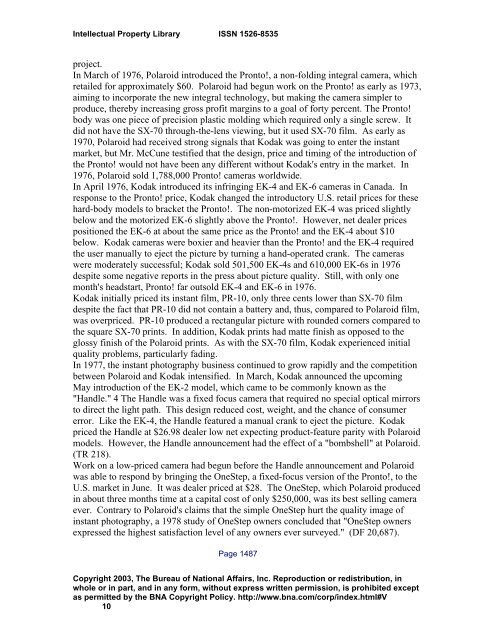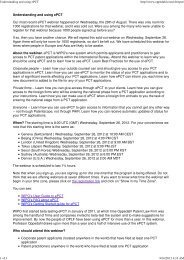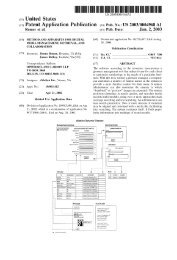Polaroid Corp. v. Eastman Kodak Co. - Oppedahl Patent Law Firm LLC
Polaroid Corp. v. Eastman Kodak Co. - Oppedahl Patent Law Firm LLC
Polaroid Corp. v. Eastman Kodak Co. - Oppedahl Patent Law Firm LLC
You also want an ePaper? Increase the reach of your titles
YUMPU automatically turns print PDFs into web optimized ePapers that Google loves.
Intellectual Property Library ISSN 1526-8535<br />
project.<br />
In March of 1976, <strong>Polaroid</strong> introduced the Pronto!, a non-folding integral camera, which<br />
retailed for approximately $60. <strong>Polaroid</strong> had begun work on the Pronto! as early as 1973,<br />
aiming to incorporate the new integral technology, but making the camera simpler to<br />
produce, thereby increasing gross profit margins to a goal of forty percent. The Pronto!<br />
body was one piece of precision plastic molding which required only a single screw. It<br />
did not have the SX-70 through-the-lens viewing, but it used SX-70 film. As early as<br />
1970, <strong>Polaroid</strong> had received strong signals that <strong>Kodak</strong> was going to enter the instant<br />
market, but Mr. McCune testified that the design, price and timing of the introduction of<br />
the Pronto! would not have been any different without <strong>Kodak</strong>'s entry in the market. In<br />
1976, <strong>Polaroid</strong> sold 1,788,000 Pronto! cameras worldwide.<br />
In April 1976, <strong>Kodak</strong> introduced its infringing EK-4 and EK-6 cameras in Canada. In<br />
response to the Pronto! price, <strong>Kodak</strong> changed the introductory U.S. retail prices for these<br />
hard-body models to bracket the Pronto!. The non-motorized EK-4 was priced slightly<br />
below and the motorized EK-6 slightly above the Pronto!. However, net dealer prices<br />
positioned the EK-6 at about the same price as the Pronto! and the EK-4 about $10<br />
below. <strong>Kodak</strong> cameras were boxier and heavier than the Pronto! and the EK-4 required<br />
the user manually to eject the picture by turning a hand-operated crank. The cameras<br />
were moderately successful; <strong>Kodak</strong> sold 501,500 EK-4s and 610,000 EK-6s in 1976<br />
despite some negative reports in the press about picture quality. Still, with only one<br />
month's headstart, Pronto! far outsold EK-4 and EK-6 in 1976.<br />
<strong>Kodak</strong> initially priced its instant film, PR-10, only three cents lower than SX-70 film<br />
despite the fact that PR-10 did not contain a battery and, thus, compared to <strong>Polaroid</strong> film,<br />
was overpriced. PR-10 produced a rectangular picture with rounded corners compared to<br />
the square SX-70 prints. In addition, <strong>Kodak</strong> prints had matte finish as opposed to the<br />
glossy finish of the <strong>Polaroid</strong> prints. As with the SX-70 film, <strong>Kodak</strong> experienced initial<br />
quality problems, particularly fading.<br />
In 1977, the instant photography business continued to grow rapidly and the competition<br />
between <strong>Polaroid</strong> and <strong>Kodak</strong> intensified. In March, <strong>Kodak</strong> announced the upcoming<br />
May introduction of the EK-2 model, which came to be commonly known as the<br />
"Handle." 4 The Handle was a fixed focus camera that required no special optical mirrors<br />
to direct the light path. This design reduced cost, weight, and the chance of consumer<br />
error. Like the EK-4, the Handle featured a manual crank to eject the picture. <strong>Kodak</strong><br />
priced the Handle at $26.98 dealer low net expecting product-feature parity with <strong>Polaroid</strong><br />
models. However, the Handle announcement had the effect of a "bombshell" at <strong>Polaroid</strong>.<br />
(TR 218).<br />
Work on a low-priced camera had begun before the Handle announcement and <strong>Polaroid</strong><br />
was able to respond by bringing the OneStep, a fixed-focus version of the Pronto!, to the<br />
U.S. market in June. It was dealer priced at $28. The OneStep, which <strong>Polaroid</strong> produced<br />
in about three months time at a capital cost of only $250,000, was its best selling camera<br />
ever. <strong>Co</strong>ntrary to <strong>Polaroid</strong>'s claims that the simple OneStep hurt the quality image of<br />
instant photography, a 1978 study of OneStep owners concluded that "OneStep owners<br />
expressed the highest satisfaction level of any owners ever surveyed." (DF 20,687).<br />
Page 1487<br />
<strong>Co</strong>pyright 2003, The Bureau of National Affairs, Inc. Reproduction or redistribution, in<br />
whole or in part, and in any form, without express written permission, is prohibited except<br />
as permitted by the BNA <strong>Co</strong>pyright Policy. http://www.bna.com/corp/index.html#V<br />
10





